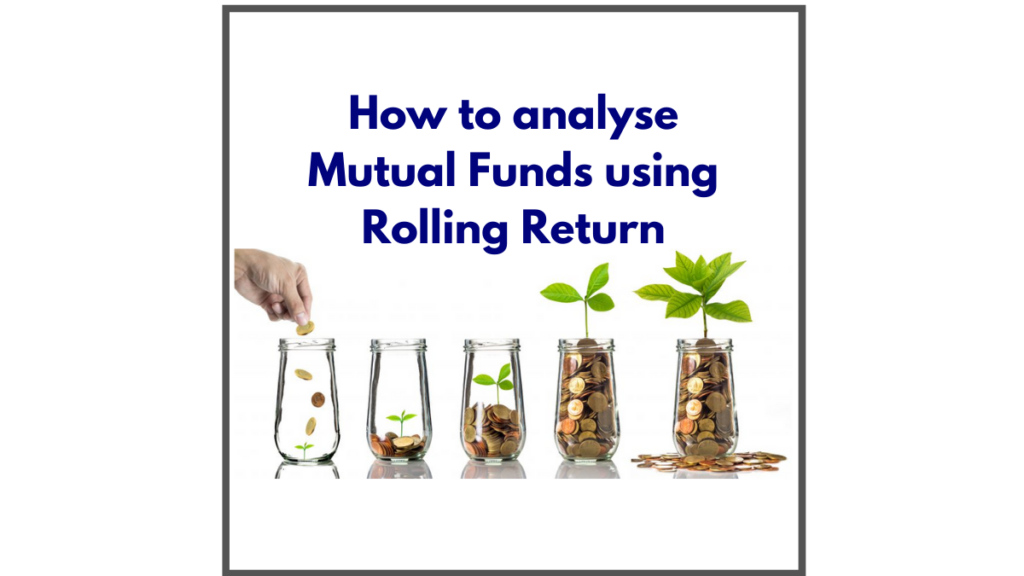Mutual funds analysis includes various parameters. The analysis of returns is one of the most important ones. Because it gives a clear picture of how the fund performed in the past during different periods.

What is Rolling Return
Rolling return is the annualized average return for the selected period beginning at a given start date and advancing one day sequentially till the last available date. Rolling returns are also known as rolling period return or rolling time periods.
It measures the fund’s absolute performance over some time period at regular intervals. Rolling return provides a more accurate and in-depth picture of a fund’s performance as return is calculated every day for the period under observation rather than being dependent on any specific time frame.
How to calculate Rolling Return?
The understanding of the rolling return is more clear when we know how it is computed. It is more time dynamic & sensitive as compared to other returns. Rolling returns deliver a more transparent picture of the fund’s performance. The return removes the impact of time of entry & time of exit in a scheme.
Calculating rolling return is little bit complex but can be done on an excel sheet using the correct inputs. Firstly, get the entire NAV history of the fund in excel. This is available on AMCs websites.
For example:
If we calculate 3 year rolling return of a mutual fund from time period 2016 to 2020. We will calculate 3 year return for the fund on each day falling during the time period 2016 to 2020. This will derive a series of 3 year returns as on each date for the entire 5 years.
We require NAV data of 8 years for this calculation. This is because the start date itself needs 3 year return & our period of consideration is 5 years i.e. 5 calendar years from 2016 to 2020.
For calculation here, our start date will be 3 years back from 1 January 2016 i.e. 1 January 2013. Then, calculate 3 year rolling return for 1 January 2016, using the following formula:

The formula will apply to every day till 31 December 2020. Which means, copy this formula to each date till 31 December 2020. Each cell will show 3-year return as on the corresponding date in the row.
The rolling return calculation requires following 2 factors:
(i) Decide the overall time period of calculation of returns (3 years, 5 years, 7 years & so on) which in above example we took 5 years.
(ii) Finalize the intervals on which the returns will be considered (6 months interval, 1 year interval, 3 year interval and so on) which we have taken as 3 year.
Decide the intervals depending upon the time period for which you want to evaluate the returns.
Why rolling returns are better to analyze mutual funds?
Websites provide return figures for 1-year, 3-year, 5-year, since inception returns etc. They provide return from a single date to a single date and point to point returns for example the one year return of the fund for 1-Jan-2020 gives the fund’s performance from 1-Jan-2019 to 1-Jan-2020. Looking at returns only on a single day gives a limited view of the fund’s performance.
If we take equity mutual funds, the stocks in the portfolio suddenly rise or fall in the market in a matter of day and weeks. Thus, this causes the NAV for a particular day or for a few days to quickly shoot higher or fall. Therefore, calculating 1-year return taking that day’s NAV & then the NAV a year ago, does not draw a conclusion about that fund’s performance.
Thus, here rolling return gives a much clearer view of the performance. Point-to-point returns show different returns based on time when you invested. What an investor need to know is what would have been the return of a fund have you invested on any day in the market. Rolling returns will help you assess this.
How to analyze rolling returns of mutual funds?
If an investment displays an 8% annualized return (not rolling return) over a 10-year period, this shows that if you invested on Jan 1 in Year 0, and sold your investment on Dec 31 at the conclusion of Year 10, you earned the equivalent of 8% a year. Yet during those 10 years, returns could have varied drastically.
In Year 4, the investment could have moved up 30%, while in Year 8 it could have dropped 18%. Yet this 8% (the “average annualized” return), might misrepresent the investment’s performance. Analyzing rolling returns instead demonstrates annual performance not simply starting Jan 1 & ending Dec 31. But also, beginning Feb 1 & ending Jan 31 of the next year; March 1 through Feb. 31 of the next year, and so on. A 10-year rolling return highlights an investment’s best & worst decades in this form.
Importance of rolling return of mutual funds
- Rolling returns are more concentrated on the holding period rather than on the time of entry and exit into the scheme.
- Rolling returns help the investor to choose the best fund in terms of performance as well as consistency.
- It helps the investor gauge performance across blocks of time, capturing market behavior over multiple periods.
- In rolling return one can use different intervals- 3 year, 5 year or 10 year period to see the highest, lowest and average returns accrued by a fund over a time period.
- With the regular and equated examination performed by rolling returns, the calculation of fund performance becomes much more accurate.
- Rolling returns are more accurate and gives proper insights to the investor.
Rolling Returns of some Equity Large Cap Funds
A comparative view with the benchmark returns as well as other mutual funds of the category, provides clear view of the funds’ performance.



Parameters for Analysis
In terms of rolling return, Axis Bluechip Fund is the best performing in comparison with other mutual funds of the category.



Drop us your query at – info@pawealth.in or Visit pawealth.in
References: Industry’s Publications & Websites of AMCs .
Disclaimer: The report only represents personal opinions and views of the author. No part of the report should be considered as recommendation for buying/selling any stock/fund. Thus, the report & references mentioned are only for the information of the readers about the industry stated.






How is return consistency (% of times) calculated….and wht does it represent?
Thanks for the question. While calculating the rolling return in excel, we get a long list of 3 year returns on each day falling within the selected tenure of calculation (here Sept 2015 to Sept 2020). Then for checking consistency, we compute from that list of returns that how many times (as a % of total times we calculated return in excel) the return was less than 0%, 0-8%, 8-12% and so on…
Thus, it tells how consistently the fund performed over whole period of calculation from Sept 15 to Sept 20. Unlike other returns which tell the performance from point to point.
This is a good parameter for comparing the performance of MF, however, this is not readily available in popular sites. Retail investors lack time & capability to calculate the rolling return. From where we can access the rolling returns of various funds.
Yes it is a good parameter. Currently the returns are not available online on any public platform. Our research team collected the data from AMCs websites for calculations using inhouse software.